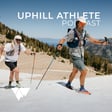
General Training Theory: Training Zones and How to Use Them
In the latest Uphill Athlete episode, Alyssa and Chantelle discuss the most commonly asked questions from Uphill Athletes. The topic of their discussion revolves around training zones, what they are, how to use them, and how to set them up for your training. They break down the procedures of establishing aerobic and anaerobic thresholds and why you might need training zones. Lastly, they touch on Rate of Perceived Exertion and Aerobic Deficiency Syndrome in regards to the evolution of training principles and guidance. If you’ve ever wondered about training zones, this episode will answer all your questions.
Useful articles: https://uphillathlete.com/aerobic-training/aerobic-anaerobic-threshold-self-assessment/
https://uphillathlete.com/aerobic-training/heart-rate-drift/



















